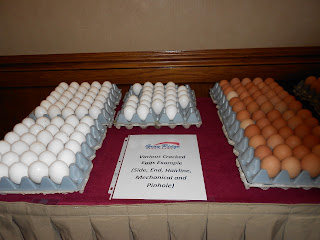Mischa Popoff, a research associate at the Frontier Centre for Public
Policy and co-author of Canada’s Organic Nightmare, says there’s an organic
certifying body in Canada that did no checking to ensure compliance.
He says the certifier, which he does not name, licenced producers as
far away as Mexico and China without ever visiting to check their integrity.
 |
| Mischa Popoff |
And he says the Canadian Food Inspection Agency, which accepts
certification by a number of bodies, was shocked when it did its own checking.
“When staff at the CFIA finally carried out some secret tests on
organic products, they were so taken aback by the results that they actually
tried to suppress them,” Dr. Doug Powell reports on his internet service for
subscribers.
“A recent in-depth report on the Canadian organic sector published by
The Frontier Centre points out that there is no systematic, empirical proof
that food certified as organic is purer, tastier or more nutritious,” he writes.
“The politicized privilege to be deemed ‘certified-organic’ in Canada
is available to anyone, whether here in Canada or anywhere in the world.
“To qualify, just pay fees and fill out paperwork, even if you’re in
China, Mexico or Argentina.
“The honesty of the applicants is not verified.”
Popoff says it would cost 10 times less to test foods that claim to be
organically-produced than ‘relying exclusively on paperwork, (but) Canada’s
for-profit organic certifiers benefit from highly-lucrative revenues which, in
turn, provide donations to activist organic groups which may explain their
opposition to testing in spite of support for the idea from rank-and-file
Canadian organic farmers.”
In addition to upfront application and inspection fees, organic
farmers and processors operating under CFIA rules are forced to pay royalties
to their private certifiers between one and three per cent on their gross
revenue from each and every transaction, Popoff says.
“It is akin to the franchise fees that fast-food restaurant owners pay
to their head offices, with the difference that Canadian organic farmers and
processors are paying for the use of the CFIA’s logo on their finished
products, not the private certifier’s.
“And yet, the CFIA requires no testing. None,” he says.
The independent inspectors make pre-announced visits once a year to
each farm and facility, but they don’t do any testing. “They only fill out
paperwork,” Popoff says.
“In addition to organic foods, you’ll also be hit with the idea of
bringing in the New Year with certified-organic booze.
“Such claim could not possibly get any more absurd.
“None of the alleged mystical attributes of organic barley or grapes
even has a chance of surviving the fermentation and distillation processes.
“So save your money,” says Popoff.







